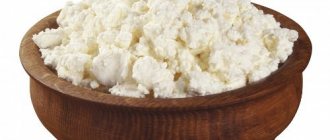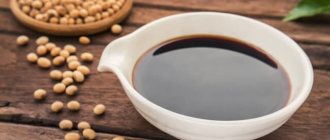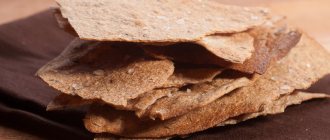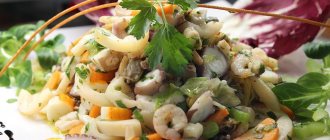Mussels are high in protein and low in carbohydrates, and dishes with them are perfect for your diet. Find out all about the benefits and calorie content of mussels, get 8 delicious recipes that you can use to diversify your diet.
Author: Kristina Lobanovskaya, doctor, practicing nutritionist Article updated: 11/09/2020
Ask a Question
Mussels are marine mollusks of the mytilid genus (Mytilus), which live in temperate latitudes of both hemispheres, creating huge colonies in coastal shallow waters. The bivalve shell of Mytilus, tightly closed by opening muscles, can be black, bluish-gray, brown or golden in color, its dimensions range from 5 to 20 cm. Life expectancy is 5-12 years.
Mytilids feed on small algae and the breakdown product of animal and plant tissues - detritus. The mollusk extracts nutrients from organic suspension by passing through itself up to 70 liters of sea water per day. Of the mytilid species, the most common are the Mediterranean-Black Sea, Far Eastern, and Californian. The meat of the Black Sea mussels is considered the most tender and aromatic, the Pacific mussels are the largest, they live up to 30 years.
Man has been eating sea shellfish for more than ten thousand years: archaeologists have repeatedly found mountains of empty shells near ancient settlements. The first farms for growing these mollusks were created in the 13th century in Ireland, where “pregnant” mussels were planted on oak posts dug into the seabed. Today, such farms are wooden platforms lowered into the water on ropes. On such platforms, a mytilid colony grows to the required size in 16-18 months.
The muscle and mantle of mussels are eaten. These “meat” parts are distinguished by a delicate sweetish taste and delicate aroma. The energy value of dishes made from them depends on the method of preparation and combination with other products. Thus, 100 grams of boiled mussels contain 55-58 kcal, stuffed with cheese or crackers - 140 kcal, and the calorie content of smoked mussels in oil is 175-180 kcal/100 g.
General characteristics of the product
Mussels belong to the genus of marine bivalve mollusks of the Mytilidae family. Representatives of mussels that humanity eats live mainly in the Atlantic and Pacific oceans. Mollusks especially liked the littoral zone (tidal zone with stones or sand) and the upper sublittoral zone. It is from there that fishermen catch them and put them on land for sale.
Content:
- General characteristics of the product
- Ecological Features
- Brief historical background
- Useful properties of the ingredient
- Chemical composition of seafood
- Use of the ingredient in cooking
- How to choose the right mussels
The mussel looks like two connected oblong shells. The outer surface of this shell is painted in a dark range of colors: from olive to purple, turning into black. The dark palette is diluted with minor light splashes and stripes. Average dimensions: 8 centimeters long and 4 centimeters high.
Edible mussels have one significant difference from other varieties of shellfish. The crown and anterior edge of the edible animal are aligned, while in other species they are shifted.
The triangular-oblong shape of the shells hides a strong muscle inside - the only organ of the animal that we eat. The surface of the shell is smooth and shiny; with age, it becomes overgrown with other marine inhabitants: sponges, bryozoans, balanuses and hydroiodes. They destroy the surface and lead to the destruction of the animal. The inner shell flaps are perfectly smooth (so as not to damage the muscle) with a mother-of-pearl tint.
Fresh
You can eat mussels raw, that is, fresh. But you need to be sure that the shellfish are really very fresh; frozen raw ones are not consumed. This seafood contains the alkaloid saxitoxin, which can cause poisoning and even paralysis. During heat treatment, the toxic substance decomposes. Therefore, if you want to try an exotic dish - freshly caught live mussels, you should not be too zealous, and in small quantities they are safe. Calorie content of fresh (raw) mussels is 75-78 kcal/100 g.
1 kg of shelled mussels will yield approximately 100 g of peeled mussels. Before serving shellfish, a number of procedures should be carried out with them. Shells must be thoroughly cleaned of algae and dirt. Before this, it is recommended to immerse them in water for a couple of hours, this will help sort the mollusks: the living ones will sink to the bottom, and the dead ones will remain on the surface.
Then place the shells in a pan of salted boiling water for 3-5 minutes until they open. Mollusks whose shells remain closed are thrown away; they are not suitable for food. The contents of the opened shells are removed quite easily. If there are a few threads left between the valves that attached the mollusk to the support, they need to be removed; everything else is edible “meat.” They are eaten with lemon juice.
Ecological Features
All littoral organisms are adapted to unfavorable environmental conditions, otherwise they simply would not survive through natural selection. At low tide, the mussel tightly closes the valves of its shell. A certain amount of sea water gets inside. The liquid enters the mantle plane and from there the mollusk scoops it up to maintain its vital functions. Sea water reserves last for several days.
The tide manages to change the ebb, and the mussel opens its doors again and returns to its usual daily routine. Animals are also able to withstand sharp temperature fluctuations (both daily and seasonal).
Possible harm
Like any highly nutritious product, mussels have a number of contraindications for consumption. These include:
- predisposition to seafood allergies;
- lactation period;
- poor blood clotting (mussels tend to thin it);
- kidney pathologies, since excess protein can provoke their exacerbation.
The product in oil can cause harm to the body in the presence of pancreatitis, acute forms of diseases of the gastrointestinal tract, cholecystitis.
In nature, mussels tend to filter water, accumulating harmful substances. Therefore, you cannot eat them right away. Seafood for sale is pre-washed with running water, so it is absolutely harmless.
To reduce the risk of poisoning to zero, you should pay attention to a number of factors when choosing:
- Freshness, as evidenced by the salty smell of the ocean.
- Tightly closed shell valves.
- No putrid odor, external damage or whitish coating on the surface.
It is not recommended to abuse this delicacy.
Brief historical background
Mussels were present in the diet of the ancient Romans (about 70 thousand years ago). Catch and artificial breeding began in the 13th century in Ireland. Several centuries later, production reached an industrial scale: entire farms were created for growing seafood, export supplies were established, strong trade relations were established, and new varieties of mussels began to be developed. Today, the leading countries of the world are engaged in industrial cultivation of mussels: Australia, China, Spain, Scotland, Japan, Belgium, France, Chile.
The population of Belgium loved the seafood delicacy so much that the locals decided to organize a mussel festival. It is held annually at the end of August. All thematic establishments of the country and coastal areas are filled with celebration, dishes and clients.
In what form is it best to consume them: fried, boiled, canned?
After purchasing shellfish, it is recommended to cook them on the day of purchase.

It is recommended to thoroughly rinse the product to remove sand and other contaminants. If you plan to keep them fresh, they should be refrigerated for no more than two days.
If the shellfish are tender, it is better to boil them in salted water over high heat with seasonings.
Like all meat products, they are best consumed during the day, or at least in the evening.
The daily intake is calculated by the number of kilocalories required by the body.
Like any product, it is better not to overeat them.
You will learn a few more interesting facts about the dangers and benefits of mussels for our body from this video:
Useful properties of the ingredient
Selenium
Selenium (Se) is one of the most important components of hormones. These hormones work tirelessly every day to ensure that a person feels good and is able to experience happiness. The element helps the body absorb iodine better, faster and more efficiently. This, in turn, guarantees the health of the thyroid gland, the main hormone-producing organ.
Selenium helps strengthen the protective function of the immune system and protects us from pathogenic microflora. Scientists have found that the element can prevent the development of herpes. If the HPV virus has already settled in the body, then selenium minimizes its manifestations and reduces exacerbations of herpes to zero.

Doctors point out the importance of consuming products with selenium after long-term therapy with “heavy” medications. The element will restore liver cells, improve mineral metabolism, and prevent the development of stones. Therefore, in addition to traditional probiotics, also pay attention to seafood.
The benefits of selenium are most noticeable for women during pregnancy. The element reduces the duration and severity of toxicosis. Instead of languishing from toxicosis, organize an evening at a specialized fish restaurant. In addition, such an event will also cause emotional release. In addition to reducing toxicosis, selenium promotes normal intrauterine development of the fetus and significantly improves the well-being and appearance of the mother.
Men should also pay attention to mussels. Selenium helps balance male hormonal levels. Androgens and testosterone bring not only unshakable confidence, but also increased libido.
Sodium
Sodium (Na) is the main ion in human blood. In addition, the element supports the health of the muscle corset, the functionality of nervous activity, and the equal distribution of fluid throughout the body. Sodium is also responsible for the transport function within the human body.
In the process of evolution, humans consumed little sodium and our body resorted to a little trick. Even minimal intake of sodium into the body leads to its supply and accumulation. The body specifically holds the element and uses it very carefully.
Modern man is no longer afraid of sodium deficiency. Only 100 grams of mussels contain 280 milligrams of the element. Now humanity suffers from an excess of the component:
- swelling;
- hypertension;
- kidney diseases.
To avoid going overboard with sodium, watch your own diet. The main sodium blocker, potassium, should always be in your menu and balance the balance of forces. Don't forget about the dosage of seafood. Allow yourself 2-3 fish meals a week to nourish your body with nutrients and minimize possible risks.
Protein

100 grams of mussels contain about 15 grams of protein. Moreover, protein from seafood is absorbed much faster and easier than animal protein from beef. Mussel meat is much easier to digest, does not cause heaviness in the stomach and eliminates abdominal pain, nausea, vomiting, and heartburn.
Vitamins and fatty acids
The benefits of vitamins and fatty acids are:
- improving skin condition;
- slowing down the aging process;
- release of free radicals;
- formation of a strong and beautiful nail plate and hair follicle;
- regeneration of the body.
Diets
Experts say that fresh mussels bring the greatest benefit to the body. Pickled shellfish are considered less valuable.
There are many diets that include mussels. The most popular are two options in which shells act as the main ingredient.
- Mediterranean - the basis of the table is seafood, it is allowed to combine them with fresh vegetables, fruits, and a small amount of cereals (5-7 meals a day, small portions).
- Mono-diet - the essence is to consume one protein; nutritionists call such a diet strict; they do not recommend using it for more than 4 days.
A protein diet is valuable for those involved in sports or fitness. It helps get rid of fat deposits without compromising muscle mass.
Whatever the diet with mussels, it is important to remember that it is not at all necessary to include them in the daily menu. 3-4 times a week is enough. The product can be used in a form that does not contradict the principles of the dietary table.
Mussels in oil
It is generally accepted that fresh shells are the healthiest. But sometimes shellfish marinated in oil bring more benefits to the body. This refers to a preparation method that does not use preservatives.
- fast absorption;
- enrichment with vitamins E and D (with oil the body receives more of these nutrients);
- improving the functioning of the digestive system.
You should stop using it if you have pathologies of the liver, pancreas, gallstones, or cholecystitis. The product is not suitable for weight loss either, since its calorie content is 900 Kcal.
In brine
One way to marinate mussels involves using brine. Due to its low calorie content, the product can be included in the diet when losing weight. Its peculiarity is to improve the functioning of the digestive system.
People who have high blood pressure, have been diagnosed with kidney pathologies, or have a tendency to edema should be careful when consuming shells in brine. Salt provokes exacerbations in such problems.
Chemical composition of seafood
Nutritional value (per 100 grams of raw product)
| Calorie content | 77 kcal |
| Squirrels | 11.5 g |
| Fats | 2 g |
| Carbohydrates | 3.3 g |
| Alimentary fiber | 0 g |
| Water | 82 g |
| Ash | 1.6 g |
Vitamin composition (in milligrams per 100 grams of raw product)
| Retinol (A) | 0,06 |
| Thiamine (B1) | 0,1 |
| Riboflavin (B2) | 0,14 |
| Ascorbic acid (C) | 1 |
| Tocopherol (E) | 0,9 |
| Nicotinic acid (PP) | 3,7 |
Nutrient balance (in milligrams per 100 grams of raw product)
| Macronutrients | |
| Potassium (K) | 310 |
| Calcium (Ca) | 50 |
| Magnesium (Mg) | 30 |
| Sodium (Na) | 290 |
| Sulfur (S) | 115 |
| Phosphorus (P) | 210 |
| Microelements | |
| Iron (Fe) | 0,0032 |
Pickled
The calorie content of marinated mussels is the same as salted ones - from 67 to 75 kcal/100 g, and the energy value of marinated mussels with the addition of vegetable oil is 130-140 kcal/100 g.

In the classic cooking method, for 150 g of peeled shellfish you will need:
- 1 glass of water;
- 2 tbsp. l. fruit vinegar;
- 1 tsp. salt;
- 0.5 tsp. Sahara;
- allspice;
- Bay leaf.
Thawed, peeled mussels are washed with running water, placed in a container and poured with hot marinade. Close the container with a lid and shake the contents well. After cooling, the container is placed in the refrigerator for a day.
To prepare the marinade, you can use lemon juice, soy sauce, add fresh garlic, smoked paprika powder, spices for Korean carrots, basil, parsley and dill, mustard, olive oil.
Use of the ingredient in cooking
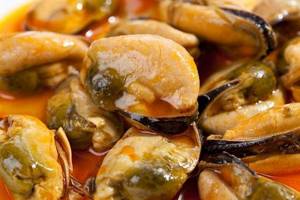
Mussel meat (represents a muscle) is very tender and soft. The taste is vaguely reminiscent of the white of a chicken or quail egg with a richer and more harmonious taste. The culinary palette of seafood consists of a viscous, sweetish taste, which is replaced by a pleasant marine note.
Only tightly closed mussels are used for food. The sashes must be smooth and complete. Even with the slightest damage, the mollusk becomes unfit for consumption.
Most often, shellfish are boiled or baked. Heat treatment helps the mussels open up and acquire a softer taste (the overcooked product becomes tough and almost impossible to chew). If the animal does not open the flaps during cooking, then it is not used. Nobody eats the shells themselves; the main delicacy of mussels is the mantle, muscle and liquid that is inside.
How to prepare shellfish:
- fry in a frying pan;
- baked on the grill/oven/over a fire;
- boil in broth/wine/plain water with spices;
- marinate;
- canned;
- stew;
- smoke;
- steamed.
Recipe for risotto with mussels and shrimp
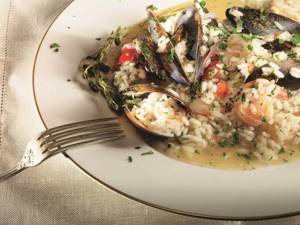
We will need:
- rice – 400 g;
- mussels – 500 g;
- tomatoes – 250 g;
- shrimp – 350 g;
- onion – 1 piece;
- dry white wine – 200 ml;
- dry martini – 50 ml;
- vegetable oil to taste – 10 ml;
- vegetable broth (can be replaced with fish or seafood broth) – 1.5-2 l;
- lemon – 1 piece;
- spices and herbs to taste.
Preparation
Prepare a saucepan and fry the chopped garlic in it (adding a drop of vegetable oil for frying).
As soon as the onion becomes soft and begins to turn golden brown, add the rest of the ingredients. Pour wine into the pan, add a few sprigs of thyme, your favorite spices and add the main component of the dish - mussels. Leave the mixture to simmer for 1-2 minutes, then add the peeled shrimp.
An important culinary aspect: if you use fresh mussels, there is no need to salt the dish. Seafood contains a sufficient amount of salt, which will be transferred to other components. If the mussels were frozen (i.e. a number of properties have already been lost), then salt must be added. Try the dish periodically and focus on your taste preferences.
Cover the pan tightly with a lid, set the heat to medium and cook the contents for about 2-3 minutes. As soon as the mussel doors open, add chopped tomatoes, herbs and, if necessary, spices to the pan. Stir and remove from heat.
While cooking the mussels, prepare the rice. Fry rice in a saucepan with a drop of vegetable oil. The grains must be completely saturated with oil, filled with taste and aromatic components. Then pour the broth into the saucepan and bring it to a boil. After boiling, reduce the temperature and cook, stirring constantly, until the broth has completely evaporated. While cooking, add a martini glass and spices to taste into the broth.
As soon as the broth has boiled away, pour the contents of the first saucepan into the rice, pour in lemon juice and serve immediately before the food has cooled.
How to properly clean mussels?
It all depends on where you will eat boiled seafood - at home or in a restaurant.
Advice from nutritionist Irina Shilina Healthy eating is incompatible with strict dietary restrictions, malnutrition and prolonged fasting. Today there is no need to strive for abnormal thinness by depriving yourself of food! Check out the latest weight loss techniques for 2021. Find out the secret ->
- If you choose the second option, then the waiter will immediately serve you a fork and tweezers. You need to hold it with tweezers and use another device to remove the meat from the sink.
- If you are served raw mussels, then you can bring the shell to your mouth and, as if from a cup, begin to suck in the healthy product.
When eating shellfish at home, there are also no particular difficulties, since boiled mussels will open the shell after processing. The product will contain pebbles, grains of sand, fragments of valves and a tuft of algae (beard). The buyer simply needs to remove unnecessary debris and separate the meat from the flaps.
If you bought a frozen product, then you should follow this action plan:
- We select only tightly closed shells and place them in the pan. After that, fill it with water and add a little corn flour. Leave for an hour. This way you can remove the sand that is contained in the sinks.
- If you notice antennae, you need to remove them with pliers or a knife, pulling them towards the base of the shell. Next, clean the mussel shells with a stiff brush.
- We rinse the product and immediately begin cooking.
How to clean fresh shellfish yourself? We choose according to the same principle: closed, intact and undamaged shells. Pour cold water into a saucepan and place the selected shellfish there.
If 30 minutes have passed, then you need to scrub the sinks with a brush. Set aside cleaned foods in clean water. After this you can start cooking.
Helpful tip: when the clams are only slightly open, you should press on them, and if the shells slam shut, you can start cooking. Otherwise, doubts arise about the freshness of the product; it is better not to consume it.


